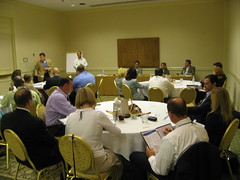Notes on Rich Media Marketing from the Frost & Sullivan session moderated by Chris Young of Doubleclick, which was entitled “Brand Building: Engaging Your Target Audience with Rich Media and Video.” Kyoo Kim from MSNBC ad sales, Barbara Cerf from New York Life, and Craig Oldham of Allstate Insurance were the panelists.
Two different formats typically used include pre-roll ads and “in banner,” an ad within a page. Barbara is testing on-page ads because she finds pre-roll irritating. Kyoo mentioned heavy.com, which gave him his “aha!” moment, when he saw that it is possible to create rich media flash players instead of annoying users with the pre-roll. Craig uses :15 pre-rolls instead of :30s. He hasn’t seen video ads do better than the “dancing clown” so far, so it’s hard to prove that creating content specifically for online channel advertising is worthwhile. Most pre-roll is currently re-purposed TV :30s.
Kyoo says ads need to be proportional; a :30 in front of a brief YouTube video doesn’t make sense, but the same ad in front of a long-form documentary is a huge value for the customer.
Check out Spotrunner.
Scale (reach and frequency) is harder to get on the web than through TV advertising. On TV, for instance, you can reach several million people at once. There isn’t enough inventory for reach and frequency. Craig doesn’t think reach and frequency matters; what he cares about is how many people in his target audience see the ad, and whether they take action. Reach and frequency is putting an old media paradigm on new media.
For the B2B market, this tonnage really doesn’t matter. As Rick Short said (he’s in the semiconductor market), being on the Today show is irrelevant for his business: there might be three viewers who could possibly buy his product. But he can go to an industry-focused web site and reach 15,000 likely customers, for much less money.
I asked whether the panelists are doing anything to create ads that people actually want to see, instead of the interruptive, intrusive ads that annoy. Chris said DoubleClick is contracted with Digital Broadcasting Group, which produces original webisodes. For example, THQ has a video game called StuntMan coming out soon, and DBG is producing 3-minute episodes of a guy going around doing crazy stunts that THQ is sponsoring and is syndicating around the web.

Jeremiah Owyang asked about whether they have pursued consumers creating advertising (He’s blogging the conference here), and how the marketers are defining and measuring success. Doubleclick is pioneering something with webcams that lets users insert themselves into ads, and forward them to friends.
Craig says Allstate is exploring how to make car insurance something that people would even be interested enough in to want to create user-generated content.
Objectives for Rich Media Marketing could include brand awareness, direct response or, in the case of film marketing, having 8 weeks to create instant brand awareness before opening night.
Measures include click-through rates, percent of video viewed, brand awareness. For entertainment 19.2 seconds of a :30 is viewed; cars are about 21 seconds. Click-through alone isn’t enough, because people who see videos but don’t click through to the site have still seen the branding message.
Kyoo is interested in finding a way to measure “engagement” because he hears a lot about that from ad agencies. Jeremiah says he is developing a formula in the videoblogging space; hopefully he will post it.
Chris says he’s looking at who clicked on the ad, who sent it to a friend, interaction rate, time spent with the ad. For example, they had a Tiger Woods golf putting contest ad that had an 89-second time spent. The Odwalla Ken Jennings spelling contest, which I mentioned earlier here, is another one that likely has a long “time spent” factor.
I really like the panel format that Frost & Sullivan used for this, as compared with the overly interactive brainstorming groups like this one. Certainly there is value in both formats, but I would have liked to hear more from Craig from Facebook yesterday, and the format prevented it. We got to connect after the session, though, which was helpful. The panel format was still really interactive, with lots of good give and take, but we had one group conversation instead of six separate ones.
 Technorati: Web video, Marketing, MSNBC, Flash, Frost & Sullivan, liveblog, DoubleClick, Allstate, New York Life, Jeremiah Owyang
Technorati: Web video, Marketing, MSNBC, Flash, Frost & Sullivan, liveblog, DoubleClick, Allstate, New York Life, Jeremiah Owyang
2 thoughts on “Rich Media Marketing”